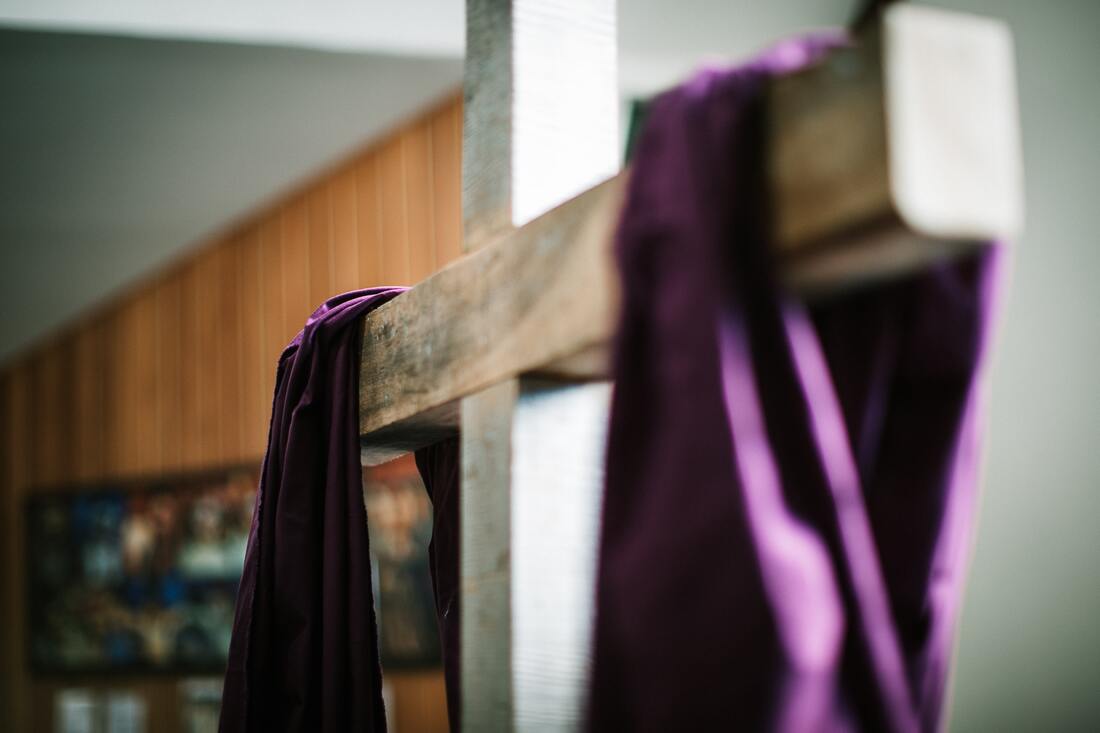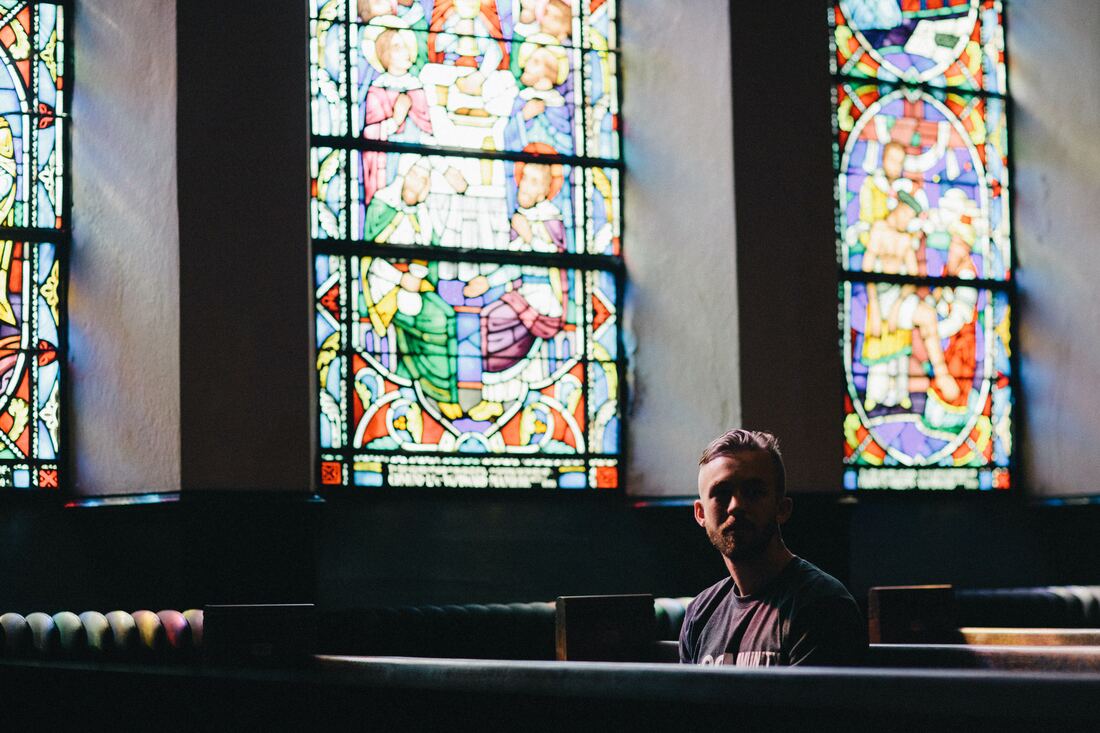It's Beginning to Look a Lot Like Lent
by Clare Schwantes
Lent has been observed since the fourth century as a period of intense fasting and study for catechumens preparing for initiation. It was also a time for penitents to prepare to be reconciled and welcomed back into the community. All members of the congregation joined with the catechumens and penitents in prayer, fasting and almsgiving.
With the rise of infant baptism and the decline of the adult catechumenate, Lent came to be regarded only as a time for repentance and self-denial. The baptismal focus of the season was emphasised anew by the Second Vatican Council in 1963 through the Constitution on the Sacred Liturgy which provides that Lent is to be marked by two themes, “the baptismal and penitential”. CSL 109.
There are a number of changes to the liturgical life of the Church in Lent that can help the assembly to enter more deeply into this reflective and penitential season. These changes need not be complicated, but their effects can be profound. They can include changes to the physical space, liturgical music, the use of silence, and opportunities to pray the Stations of the Cross or attend reconciliation services in the parish community.
With the rise of infant baptism and the decline of the adult catechumenate, Lent came to be regarded only as a time for repentance and self-denial. The baptismal focus of the season was emphasised anew by the Second Vatican Council in 1963 through the Constitution on the Sacred Liturgy which provides that Lent is to be marked by two themes, “the baptismal and penitential”. CSL 109.
There are a number of changes to the liturgical life of the Church in Lent that can help the assembly to enter more deeply into this reflective and penitential season. These changes need not be complicated, but their effects can be profound. They can include changes to the physical space, liturgical music, the use of silence, and opportunities to pray the Stations of the Cross or attend reconciliation services in the parish community.
SILENCE
Lent is the ideal time to be quite deliberate in creating spaces for silence and stillness, perhaps before Mass, at the Collect when the priest issues the invitation “Let us pray”, between the readings, after the homily, and after communion.
Musicians, readers and other liturgical ministers will all need to understand where the moments of silence will occur.
In a world which is often chaotic and deafening, silence can be an uncomfortable, awkward phenomenon. It may be helpful to announce to the congregation at the beginning of Mass that there will be moments of silence during liturgies in Lent to promote a reflective atmosphere. This is particularly important if silence has not routinely been a part of their liturgical experience.
Indeed, silence is not only an important part of the liturgy during Lent.
It is hoped that this practice might be retained throughout the entire liturgical year.
Lent is the ideal time to be quite deliberate in creating spaces for silence and stillness, perhaps before Mass, at the Collect when the priest issues the invitation “Let us pray”, between the readings, after the homily, and after communion.
Musicians, readers and other liturgical ministers will all need to understand where the moments of silence will occur.
In a world which is often chaotic and deafening, silence can be an uncomfortable, awkward phenomenon. It may be helpful to announce to the congregation at the beginning of Mass that there will be moments of silence during liturgies in Lent to promote a reflective atmosphere. This is particularly important if silence has not routinely been a part of their liturgical experience.
Indeed, silence is not only an important part of the liturgy during Lent.
It is hoped that this practice might be retained throughout the entire liturgical year.
“During liturgical silence all respond in their own way, recollecting themselves, pondering what has been heard,
petitioning and praising God in their inmost spirit.”
Catholic Bishops’ Conference of England & Wales, Celebrating the Mass 91
“Real silence though is not just an absence of noise.
We can be very noisy indeed on the inside even if the outside is quiet.
It is also possible to be quiet on the inside while chaos reigns on the outside.
This is because silence helps us get in touch with our real selves and opens the path for us to hear the still, small voice of God.”
Catholic Bishops’ Conference of England and Wales, Do you love me? A guide to Catholic Spirituality, page 41
petitioning and praising God in their inmost spirit.”
Catholic Bishops’ Conference of England & Wales, Celebrating the Mass 91
“Real silence though is not just an absence of noise.
We can be very noisy indeed on the inside even if the outside is quiet.
It is also possible to be quiet on the inside while chaos reigns on the outside.
This is because silence helps us get in touch with our real selves and opens the path for us to hear the still, small voice of God.”
Catholic Bishops’ Conference of England and Wales, Do you love me? A guide to Catholic Spirituality, page 41
MUSIC
* Praise to you, Lord Jesus Christ, King of endless glory!
* Praise and honour to you, Lord Jesus Christ!
* Glory and praise to you, Lord Jesus Christ!
* Glory to you, Word of God, Lord Jesus Christ!
The Mass of Glory and Praise, and the Shalom Mass are two examples of Mass settings that include a sung Lenten gospel acclamation.
- Sing the Penitential Rite
During Ordinary Time, to balance the Opening Rites of the Mass, it is customary to sing the Gloria and speak the Penitential Act. The season of Lent, however, is the perfect time for a sung Penitential Rite because it captures the spirit of the season, and because the Gloria is omitted during Lent.
- Mass Setting
Use the same Mass Setting throughout Lent to evoke a sense of season, preferably one that is different to that which has been sung in the previous weeks of Ordinary Time. Choose acclamations which are reflective in mood for Lent and then choose a more jubilant setting for Easter.
- Sing the Responsorial Psalm
The beautiful texts of the psalms for Lent capture the sense of God’s mercy and compassion, and the human need for conversion and repentance. If your community has yet to introduce the practice of singing the responsorial psalm, Lent would be an ideal time to do this.
- Lenten Gospel Acclamation
At all other times of the year, we welcome the gospel with a joyfully sung “Alleluia!” In Lent, however, the verse before the Gospel as given in the Lectionary is sung in place of the Alleluia”. (GIRM 62). One of the following four refrains may be used in Australia.
* Praise to you, Lord Jesus Christ, King of endless glory!
* Praise and honour to you, Lord Jesus Christ!
* Glory and praise to you, Lord Jesus Christ!
* Glory to you, Word of God, Lord Jesus Christ!
The Mass of Glory and Praise, and the Shalom Mass are two examples of Mass settings that include a sung Lenten gospel acclamation.
- Presentation of the Offerings
The General Instruction of the Roman Missal (GIRM) provides that in Lent the playing of the organ and musical instruments is only to support the singing, with the exception of Laetare Sunday (4th Sunday of Lent), Solemnities, and Feasts. (GIRM 313)
This inclination away from instrumental music is not designed to promote a gloomy atmosphere, but rather to provide a space for silence, stillness, simplicity and deep reflection. Instead of playing music to accompany the presentation of the gifts, this time could be spent in silence. After the Presider’s Blessed are you, Lord God of all creation…….., the people respond “Blessed be God for ever.”
However, some have argued that the preparation of the gifts doesn’t always lend itself to a still, prayerful silence – especially if there is a collection at the same time. It has been suggested that an instrumental reprise of the Responsorial Psalm may be appropriate here, allowing the words to echo in the minds and hearts of the assembly. The question to be asked is whether a particular instrumental piece may, in the local context, indeed encourage and cultivate the spirit of the Lenten season.
The indication against instrumental music during Lent also implies the suitability of unaccompanied a cappella singing.
If the community is very familiar with the eucharistic acclamations, for example, these could be sung without accompaniment during Lent.
- Recessional
The Recessional Hymn is always optional, as the liturgy officially ends with the dismissal. During Lent, the community might depart in silence, or an organ postlude might replace the final hymn to mark the special character of the season.
PHYSICAL SPACE
- The liturgical colour for the Season of Lent is violet. An exception occurs on the Fourth Sunday of Lent (Laetare Sunday) when rose-coloured vestments may be worn. Other exceptions include Solemnities or feasts that occur during Lent. The liturgical colour is white for celebrations of the Chair of St Peter, Saint Patrick, St Joseph, Annunciation and Chrism Mass. On Palm Sunday, the liturgical colour is red.
- The use of flowers around the altar is prohibited during Lent, with the exception of Laetare Sunday (4th Sunday of Lent) and any Solemnities or Feasts that occur during Lent. (GIRM 305). It would seem wise to refrain from decorating with other foliage or branches since the intent of the rubric seems to be aimed at simplicity and a lack of decoration in general.
EVENTS
Alternatively, penitents may be given time after the examination of conscience to write their confession. They present this written confession to the priest who reads it silently and then gives sacramental absolution aloud. It is a soul-stirring experience to join with other members of the community in a public space humbly approaching the Sacrament of Penance to seek forgiveness and absolution.
The liturgy concludes with a proclamation of praise, a thanksgiving prayer, a final blessing and perhaps a recessional hymn.
While there is an atmosphere of penitence throughout the season, the Lenten liturgies are nonetheless imbued with a hope-filled joy. Each of the liturgical modifications for Lent are designed to call members of the assembly to repentance and conversion, that they might come to the Easter celebrations with mind and heart renewed.
- Your parish might choose to pray the Stations of the Cross on Wednesdays or Fridays during Lent, as well as on Good Friday. The Church has never provided an official ritual for celebrating the Stations, but there are a number of resources available to assist the community to pray them together.
- Lent is an appropriate season in which to celebrate the Second Rite of Reconciliation in the parish. This communal celebration of reconciliation begins with a gathering hymn, introductory rites and liturgy of the word. The examination of conscience then provides an opportunity for the assembly to reflect on their relationships with God and others, and to identify areas where healing and conversion is needed.
Alternatively, penitents may be given time after the examination of conscience to write their confession. They present this written confession to the priest who reads it silently and then gives sacramental absolution aloud. It is a soul-stirring experience to join with other members of the community in a public space humbly approaching the Sacrament of Penance to seek forgiveness and absolution.
The liturgy concludes with a proclamation of praise, a thanksgiving prayer, a final blessing and perhaps a recessional hymn.
While there is an atmosphere of penitence throughout the season, the Lenten liturgies are nonetheless imbued with a hope-filled joy. Each of the liturgical modifications for Lent are designed to call members of the assembly to repentance and conversion, that they might come to the Easter celebrations with mind and heart renewed.
Text by Clare Schwantes.
Images from Unsplash and Pixabay. Used under license/with permission.
Images from Unsplash and Pixabay. Used under license/with permission.






